The Lapworth Museum of Geology has fine examples of the main vertebrate groups found in the fossil record. Our collection ranges from 500 million-year-old primitive fish of the Early Palaeozoic through to mammal remains from cold, glacial, and warmer interglacial, periods of the Pleistocene which ended approximately ten thousand years ago.
Fish
The first fish appeared around 530 million years ago and then underwent a long period of evolution so that, today, they are by far the most diverse group of vertebrates. The Lapworth Museum contains an exceptional collection of fossil fish, from most of the geological periods spanning the 530 million years of fish evolution. The collection contains many examples from classic localities in the UK and worldwide, and forms an important research resource for palaeobiologists within the School of Geography, Earth & Environmental Sciences, and internationally.
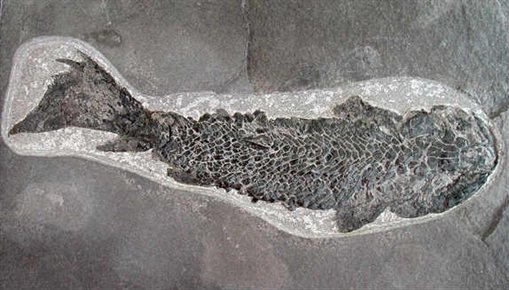
Lobe-finned fish
The first fish were primitive jawless forms (agnathans) which appeared in the Early Cambrian, but remained generally rare until the Silurian and Devonian when they underwent a rapid evolution. There are five main groups of agnathans in the collections - the conodonts, heterostracans, osteostracans, anaspids and thelodonts. Today, the only remaining jawless fish are the lampreys and hagfishes.
The museum has fine examples of the main agnathans groups. Early forms include one of the most complete specimens known of Astraspis, from the Late Ordovician, Harding Sandstone of Colorado (approximately 455 million years old). Astraspis was an agnathan covered in heavy, bony armour, and would have lived close to the sea floor. It fed on small organic matter, which it extracted from the sea floor with its simple mouth structure.
Other agnathans include a beautifully preserved example of Drepanaspis (a heterostracan) from the Devonian Hunsrück shales of Germany. The body features, including a simple tail, indicate that Drepanaspis was a poor swimmer. In addition, its flattened shape indicates that it probably lived close to the sea floor, where it fed on organic matter which it sucked up through its primitive mouth.
The osteostracans are well-represented and include a complete specimen of Hemicyclaspis murchisoni from the Birmingham area.
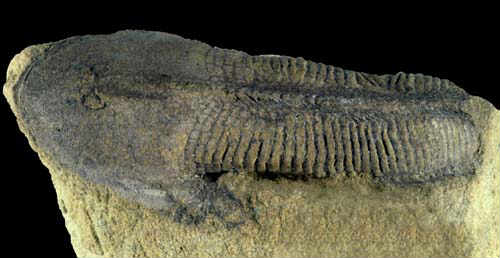
Osteostracan fish
By the Late Devonian many of the families of jawless fish had become extinct, possibly as a result of competition from the jawed fish which first appeared in the early Silurian period. The evolution of jaws allowed the fish to become active predators and they then rapidly diversified.
There are four main groups of jawed fish, two of which - the placoderms and the acanthodians - are extinct. The two other groups include most of the fish types that are known today. The chondrichthyans (or cartilaginous fishes) include sharks and rays, together with the bizarre rabbit fish and elephant fish, and the osteichthyans (the bony fishes) include all other living jawed fishes. The museum has excellent collections of these fish groups with examples from many classic, fossil fish localities, worldwide.
The museum has many specimens from the Old Red Sandstone (Devonian) sediments of northern Scotland. This thick sedimentary sequence deposited in the former Orcadian Basin of Scotland, is famous for its diverse fish fauna and represents a large freshwater lake deposit. Agnathans, such as Pteraspis, are found mainly in the older sediments within the sequence, but are less common at higher levels. Placoderms (including forms such as Bothriolepis), acanthodians, and lobe-finned fish (such as Osteolepis) are particularly common within the sequence.
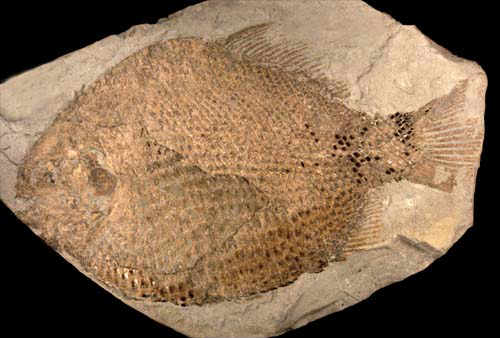
Ray-finned fish
The ray-finned bony fishes, which incorporate the majority of modern fish groups, are particularly well-represented in the collections. The museum has excellent examples of Jurassic fish from the Dorset coast of England, and many from the famous Jurassic, Solnhofen Limestone of Bavaria. There are also many specimens from the Cretaceous deposits of Mt Lebanon, including small shoals of fish; and exceptionally well-preserved examples from the Eocene Green River Formation of Wyoming, USA.
Monte Bolca, near Verona, in Northern Italy provides one of the less well known vertebrate lagerstätte. These 50 million-year-old Eocene limestones contain a diverse and exceptionally well preserved fish fauna, which was first described in the 1500s.
Amphibians are the most primitive living tetrapods (animals with, or evolved from animals with, four legs). Although evolved for life on land, they remain tied to water since they must return there to breed. Complete fossil frogs are known from the fossil record, but most representatives resemble modern newts and salamanders more closely, including some that were similar to modern crocodiles in size and feeding habit. The museum contains representatives of amphibians from Boskovice in the Czech Republic and from Lebach in Saarland, Germany. There are also large collections of amphibian trackways from the Late Carboniferous of Alveley, Shropshire.
Mesosaur: Mesosaurs were the first marine reptiles, and grew up to 1 metre in length with a large tail and paddle-like limbs, which were adapted for swimming. They had long jaws containing numerous small, sharp, teeth used to catch prey, such as small fish. They are found in rocks of Early Permian age (approximately 280 million years old) but, geographically, are restricted to rocks in western Africa and South America, from where the museum has a fine and complete specimen.
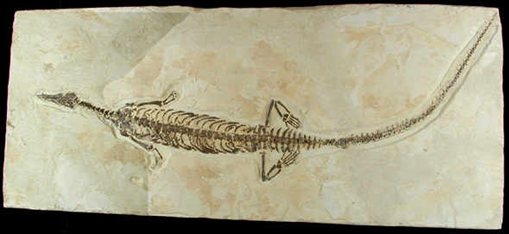
Mesosaur
Ichthyosaurs and Mososaurs: Early Jurassic seas were dominated by large marine reptiles which were some of the most accomplished marine predators. The collections include a number of complete ichthyosaurs which would have been similar in appearance to modern dolphins, although they are more closely related to crocodiles, and in earlier times were thought to be 'sea-dragons'. They possessed strong jaws, with numerous long teeth, and would have been active predators feeding on fish, ammonites and belemnites. By the Cretaceous the ichthyosaurs were in decline but, other types of marine reptiles had appeared and were dominating the seas, these included the mososaurs, active predators much larger than the ichthyosaurs with huge jaws and large conical teeth.
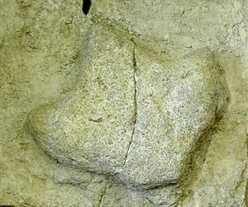 The collections include many dinosaur footprints including those made by large herbivores, such as Iguanodon, and smaller tracks made by carnivorous theropod dinosaurs. Other dinosaur remains include skulls, teeth and limb bones and eggs from Allosaurus, Velociraptor, Monoceratops and other forms. In addition, there are bird footprints from Spain and the Himalayas showing similar features to the theropod footprints and indicating the strong evolutionary links between theropod dinosaurs and birds.
The collections include many dinosaur footprints including those made by large herbivores, such as Iguanodon, and smaller tracks made by carnivorous theropod dinosaurs. Other dinosaur remains include skulls, teeth and limb bones and eggs from Allosaurus, Velociraptor, Monoceratops and other forms. In addition, there are bird footprints from Spain and the Himalayas showing similar features to the theropod footprints and indicating the strong evolutionary links between theropod dinosaurs and birds.
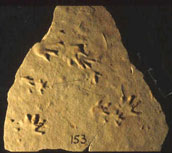 The museum has a fine collection of fossil footprints, and these trace fossils can provide valuable information about the animals which made them, particularly when actual body fossils are rare or absent in the rocks.
The museum has a fine collection of fossil footprints, and these trace fossils can provide valuable information about the animals which made them, particularly when actual body fossils are rare or absent in the rocks.
Of particular importance is a series of approximately 200 red sandstone slabs from a quarry at Alveley, in Shropshire. These rocks are 310 million years old (Westphalian D, Late Carboniferous) and, when the slabs are reassembled, they are covered by numerous footprints and complete trackways. The many types of footprints indicate a diverse fauna of different amphibians and reptiles, with both herbivorous and carnivorous forms present, and also small tracks made by crustaceans. This trace fossil assemblage provides evidence of one of the earliest tetrapod communities in the UK, even though no body fossils have been found in the sequence.
The collection also includes footprints from the Permo-Trias (New Red Sandstone) of Britain which is rich in fossil footprints with evidence of amphibians, reptiles, archosaurs and dinosaurs.
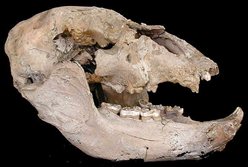 The Lapworth collections include representatives of mammals from the earliest through to the giant faunas of the Ice Ages. The earliest mammals were shrew-like creatures from the Triassic of SW England, and are represented by disarticulated teeth and bones. The Quaternary (or Pleistocene) deposits of the Midlands contain diverse mammal faunas representative of both warm and cold conditions. There include mammals such as mammoth, woolly rhinoceros and lemmings from colder glacial periods, and hippopotamus, hyaenas, lions, beavers and wild ox from the warmer interglacial periods.
The Lapworth collections include representatives of mammals from the earliest through to the giant faunas of the Ice Ages. The earliest mammals were shrew-like creatures from the Triassic of SW England, and are represented by disarticulated teeth and bones. The Quaternary (or Pleistocene) deposits of the Midlands contain diverse mammal faunas representative of both warm and cold conditions. There include mammals such as mammoth, woolly rhinoceros and lemmings from colder glacial periods, and hippopotamus, hyaenas, lions, beavers and wild ox from the warmer interglacial periods.
Many of Britain's caves are also well known for their Quaternary mammal faunas, and the Lapworth Museum contains examples of skulls and teeth from classic localities such as Kent's Cavern in Devon, including cave bears, cave hyaenas, wild horse and elephant.